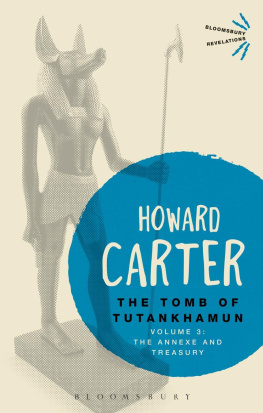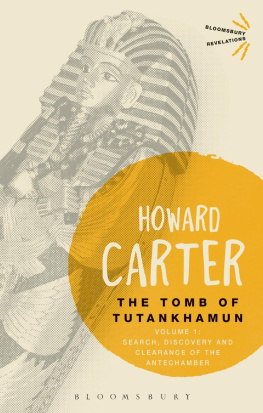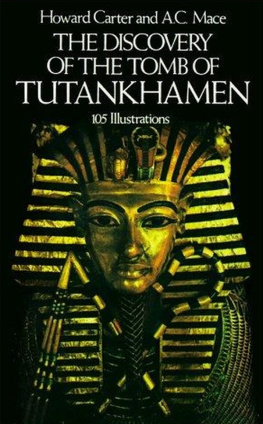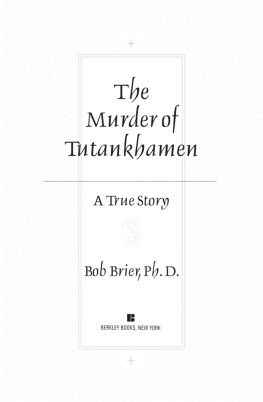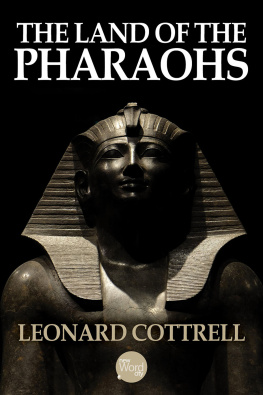TUTANKHAMEN
AND THE DISCOVERY OF HIS TOMB
The discovery of Tutankhamens tomb in 1922 aroused unprecedented excitement in the field of Egyptology. In the tomb of a colourless youth, who reigned for a few years only, were found unmatched riches, the study of which has led to numerous insights into ancient Egyptian civilization. The author of this fascinating text discusses the tombs discovery, the significance of its discovery and contents, tomb-robbers and the ethics of desecration.
www.keganpaul.com
The Kegan Paul Library of Ancient Egypt
Series Advisor
Geoffrey Thorndike Martin
Edwards Professor of Egyptology Emeritus, University College London
The Amarna Age James Baikie
Ancient Egypt the Light of the World Gerald Massey
Ancient Egyptian Literature Adolf Erman
Ancient Egyptian Scarabs and Cylinder Seals Percy Newberry
Arts and Crafts of Ancient Egypt W. M. Flinders Petrie
Burial Customs of the Ancient Egyptians John Garstang
The Cat in Ancient Egypt N. LANGTON AND B. LANGTON
A Century of Excavation in the Land of the Pharaohs James Baikie
Egyptian Art Gaston Maspero
Egyptian Mummies G. E. Smith and Warren R. Dawson
Egyptian Papyri and Papyrus-Hunting James Baikie
Egyptian Temples Margaret Murray
Everyday Life in Ancient Egypt and Assyria Gaston Maspero
First Steps in Egyptian EA. Wallis Budge
From Fetish to God in Ancient Egypt E. A. Wallis Budge
The Gods of the Egyptians E. A. Wallis Budge
A Guide to the Antiquities of Upper Egypt Arthur E. P. Weigall
Index of Names and Titles of the Old Kingdom Margaret A. Murray
The Literature of the Ancient Egyptians E. A. Wallis Budge
The Lost Pharaohs Leonard Cottrell
Luxor and Its Temples A. M. Blackman
The Mechanical Triumphs of the Ancient Egyptians F. M. Barber
Notes for the Nile Hardwicke D. Rawnsley
Notes for Travellers in Egypt E. A. Wallis Budge
Osiris E. A. Wallis Budge
Pharaohs, Fellahs and Explorers Amelia B. Edwards
A Popular Account of the Ancient Egyptians J. Gardner Wilkinson
The Pyramids and Temples of Gizeh W.M. Flinders Petrie
Researches in Sinai W. M. F. Petrie
In Search of the Woman Pharaoh Hatshepsut H.E. Winlock
Seventy Years in Archaeology W. M. F. Petrie
Travels in the Upper Egyptian Deserts Arthur E. P. Weigall
Tutankhamen and the Discovery of His Tomb G. Elliot Smith
First published in 2005 by
Kegan Paul Limited
UK: P.O. Box 256, London WC1B 3SW, England
Tel: 020 7580 5511 Fax: 020 7436 0899
E-Mail:
Internet:http://www.keganpaul.com
USA: 61 West 62nd Street, New York, NY 10023
Tel: (212) 459 0600 Fax: (212) 459 3678
Internet:http://www.columbia.edu/cu/cup
BAHRAIN:
Distributed by:
Extenza-Turpin Distribution
Stratton Business Park
Pegasus Drive
Biggleswade
SG18 8QB
United Kingdom
Tel: (01767) 604951 Fax: (01767) 601640
Email:
Columbia University Press
61 West 62nd Street, New York, NY 10023
Tel: (212) 459 0600 Fax: (212) 459 3678
Internet:http://www.columbia.edu/cu/cup
Kegan Paul, 2005
Printed in Great Britain
All Rights reserved. No part of this book may be reprinted or reproduced or utilised in any form or by any electric, mechanical or other means, now known or hereafter invented, including photocopying or recording, or in any information storage or retrieval system, without permission in writing from the publishers.
ISBN: 0-7103-1005-6
British Library Cataloguing in Publication Data
Library of Congress Cataloging-in-Publication Data
Applied for.
LIST OF ILLUSTRATIONS
FIG.
Mummy of Thothmes IV
Ancient Plan of the Tomb of Rameses IV
The Mummies of Ynaa and Tnaa
Tutankhamen receiving Ethiopian tribute from Huy
Part of the Asiatic tribute presenteted to Tutankhamen by Huy
Part of a mace-Bead, showing early Egyptian kings
Portrait of Hesi, circa 3000 B.C.
The packed mummy of a Queen of the Twenty-first Dynasty
Drawing from Book of the Dead
The end of the desolate Valley of the Tombs of the Kings at Thebes
An ancient Egyptian drawing (circa 1400 B.C.) illustrating the arrangement of the tomb and temple
The great cliffs behind Deir el Bahiari.
Lid of the coffin which contained the re-wrapped mummy of Amenliotep III.
An inscribed stone showing Akhenaton, his queen Nefertiti, and their daughters
A painted wooden portrait bust of Nefertiti, wife of Akhenaton.
The skull of Akhenatou
Cow carrying a dead man to heaven.
Narmers belt with four Hathor cows heads, curca 3044 B.C
Three couches represented on the walls of the tomb of Seti I
A lion-couch, a mummy with three solar emanations
Three givers of divinity, the cow, the hippopotamus, and Horus on guard.
The goddess Astarte borne on her lioness
PREFACE
DURING the period when the newspapers were publishing daily reports of the progress of the work in Tutankhamens tomb and Air Harry Burtons photographs, which gave us so vivid an impression of the objects that were being found, I wrote for the Daily Telegraph. a series of articles discussing the wider significance of the startling discoveries. They did not describe the tomb itself or the wonderful collection of funerary equipment, but were merely a general commentary on the meaning of the information being given by the reporters from the Theban necropolis. Nor was any attempt made to collect the few facts concerning Tutankhamen himself, or even to discuss the events of his time. The exploration of the Valley of the Tombs of the Kings, for which the late Lord Carnarvon and Mr Howard Carter were responsible, had brought to light the tomb of the youthful nonentity Tutankhamen, which sheds a dazzling searchlight on one particular phase of the history of civilization thirty centuries ago. What I set out to attempt was to interpret the deeper meaning of those Egyptian beliefs which found such brilliant expression in the luxuriously extravagant equipment of his tomb.
I have been urged to collect these articles into the more convenient form of this little book. As they were merely comments on the descriptions of the actual tomb and its contents the separate issue of these topical and ephemeral notes seemed at first to lack any justification, but I have received so many requests for information and guidance that I thought it might serve some useful purpose to redraft my articles and give such bibliographical references as would help the general reader to understand the results that have so far been attained and to appreciate the value of the more important discoveries that next seasons work will certainly reveal.



